Unit1 The lion and the mouse(写作指导)课件(共25张PPT)
文档属性
| 名称 | Unit1 The lion and the mouse(写作指导)课件(共25张PPT) |
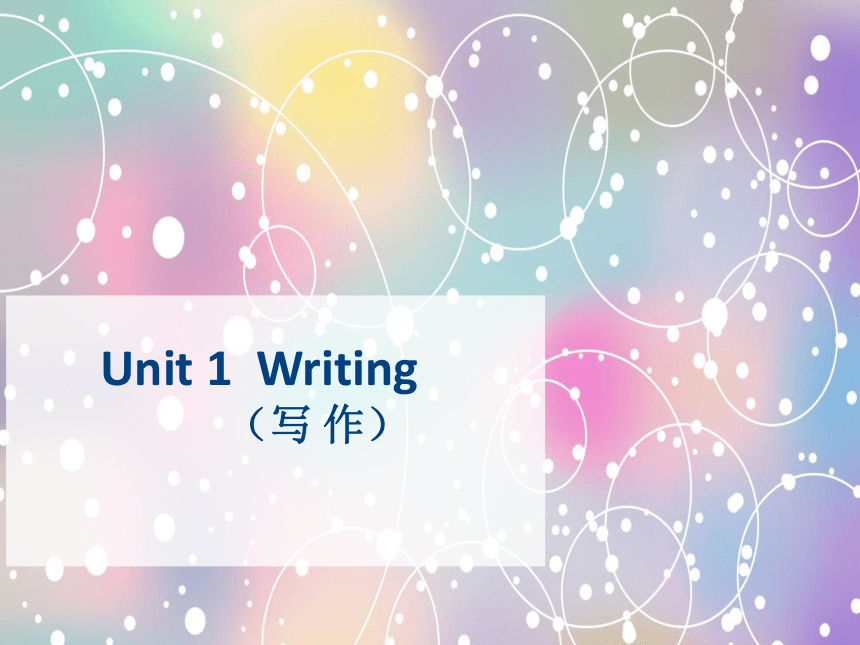
|
|
| 格式 | ppt | ||
| 文件大小 | 3.4MB | ||
| 资源类型 | 教案 | ||
| 版本资源 | 牛津译林版 | ||
| 科目 | 英语 | ||
| 更新时间 | 2023-01-23 20:46:27 | ||
图片预览

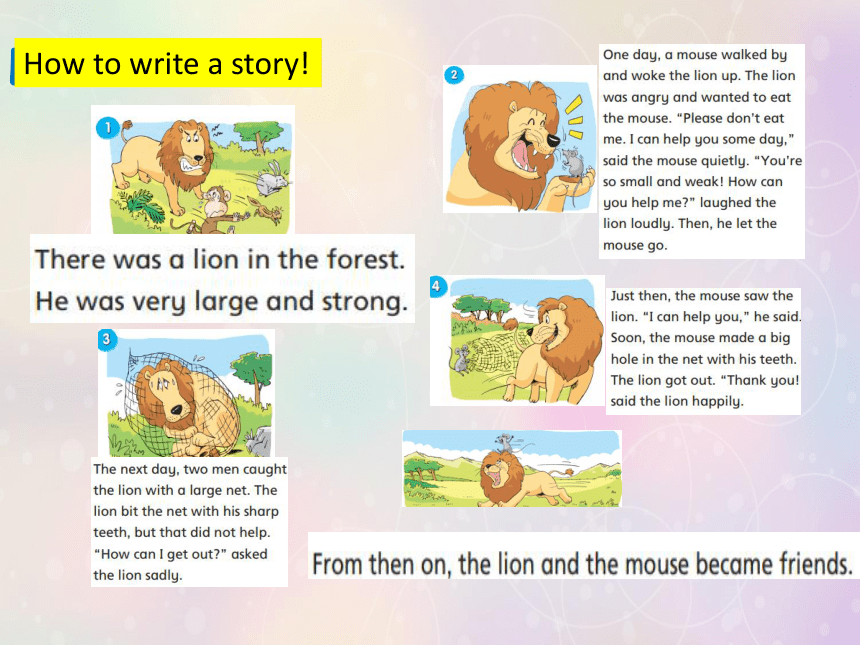
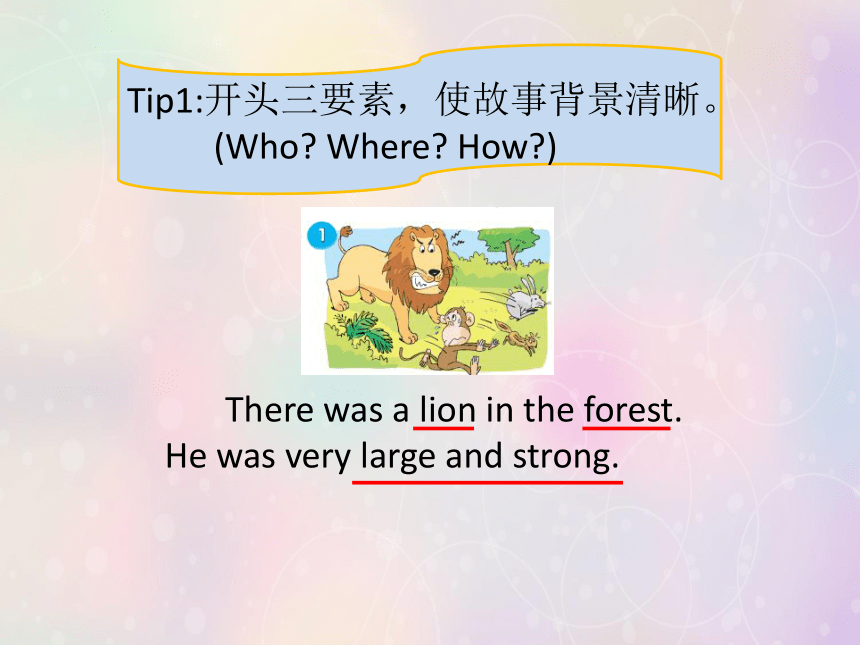

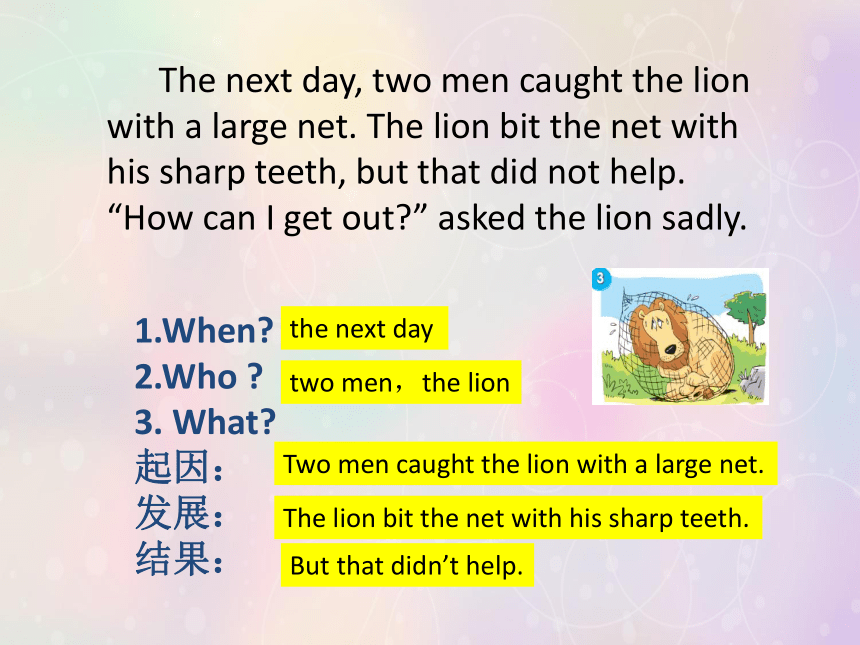

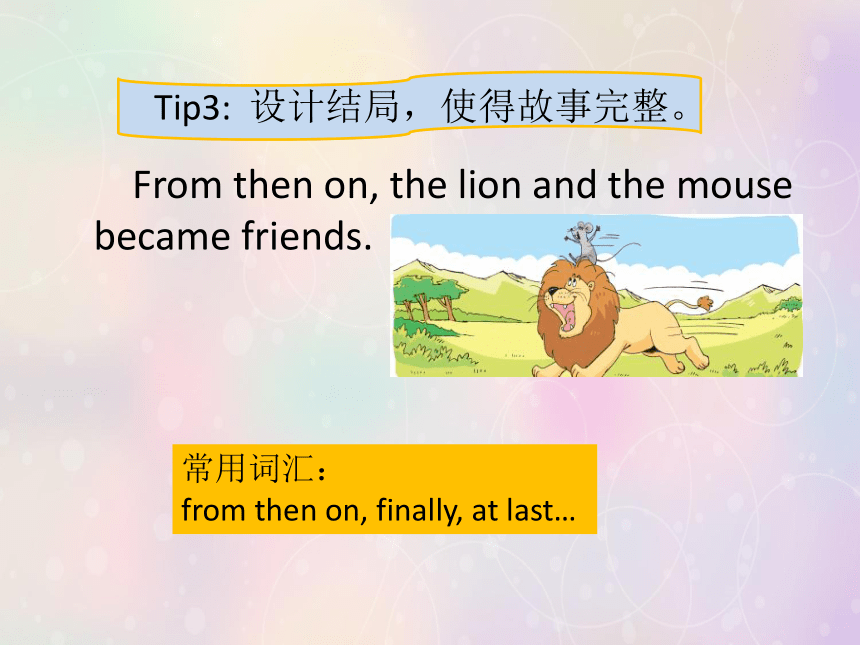
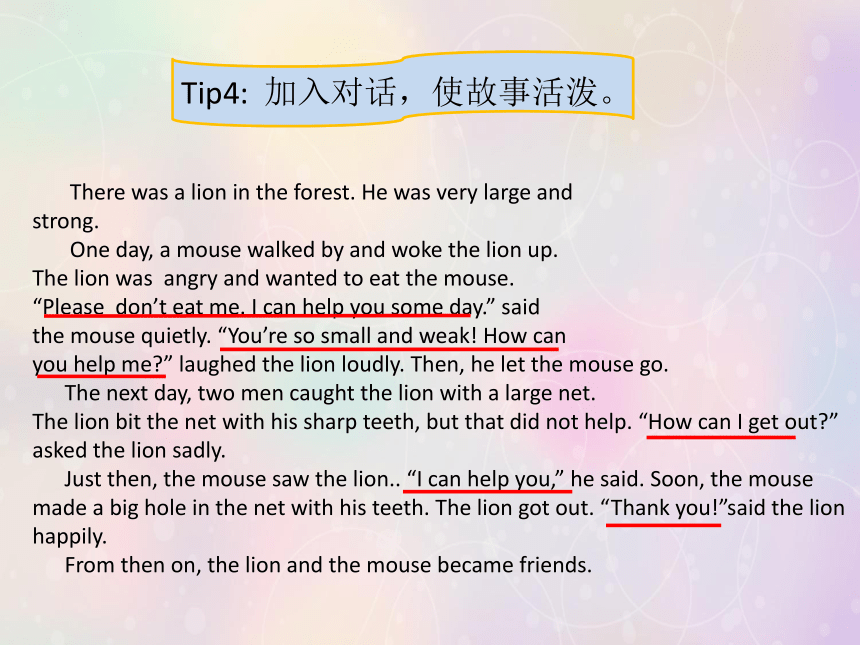
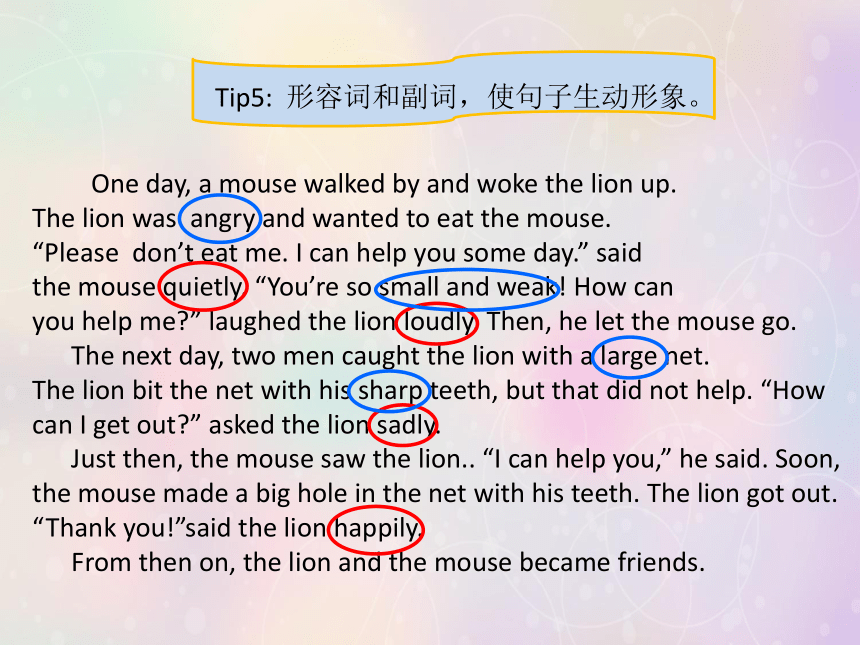
文档简介
(共25张PPT)
Unit 1 Writing
(写 作)
Let’s review!
How to write a story!
There was a lion in the forest.
He was very large and strong.
Tip1:开头三要素,使故事背景清晰。
(Who Where How )
One day, a mouse walked by and woke the lion up.
The lion was angry and wanted to eat the mouse.
“Please don’t eat me. I can help you some day.” said
the mouse quietly. “You’re so small and weak! How can
you help me ” laughed the lion loudly. Then, he let the mouse go.
Tip2: 过程三要素,使故事主体有逻辑。
起因
发展
结果
1.When (时间)
2.Who (人物)
3.What (事情)
The next day, two men caught the lion with a large net. The lion bit the net with his sharp teeth, but that did not help. “How can I get out ” asked the lion sadly.
1.When
2.Who
3. What
起因:
发展:
结果:
two men,the lion
Two men caught the lion with a large net.
The lion bit the net with his sharp teeth.
But that didn’t help.
the next day
Just then, the mouse saw the lion. “I can help you,” he said. Soon, the mouse made a big hole in the net with his teeth. The lion got out. “Thank you!”said the lion happily.
1. When
2. Who
3. What
起因:
发展:
结果:
mouse, lion
The mouse saw the lion.
The mouse made a big hole in the net…
The lion got out.
just then
From then on, the lion and the mouse became friends.
Tip3: 设计结局,使得故事完整。
常用词汇:
from then on, finally, at last…
There was a lion in the forest. He was very large and
strong.
One day, a mouse walked by and woke the lion up.
The lion was angry and wanted to eat the mouse.
“Please don’t eat me. I can help you some day.” said
the mouse quietly. “You’re so small and weak! How can
you help me ” laughed the lion loudly. Then, he let the mouse go.
The next day, two men caught the lion with a large net.
The lion bit the net with his sharp teeth, but that did not help. “How can I get out ” asked the lion sadly.
Just then, the mouse saw the lion.. “I can help you,” he said. Soon, the mouse made a big hole in the net with his teeth. The lion got out. “Thank you!”said the lion happily.
From then on, the lion and the mouse became friends.
Tip4: 加入对话,使故事活泼。
One day, a mouse walked by and woke the lion up.
The lion was angry and wanted to eat the mouse.
“Please don’t eat me. I can help you some day.” said
the mouse quietly. “You’re so small and weak! How can
you help me ” laughed the lion loudly. Then, he let the mouse go.
The next day, two men caught the lion with a large net.
The lion bit the net with his sharp teeth, but that did not help. “How can I get out ” asked the lion sadly.
Just then, the mouse saw the lion.. “I can help you,” he said. Soon, the mouse made a big hole in the net with his teeth. The lion got out. “Thank you!”said the lion happily.
From then on, the lion and the mouse became friends.
Tip5: 形容词和副词,使句子生动形象。
There was a lion in the forest. He was very large and
strong.
One day, a mouse walked by and woke the lion up.
The lion was angry and wanted to eat the mouse.
“Please don’t eat me. I can help you some day.” said
the mouse quietly. “You’re so small and weak! How can
you help me ” laughed the lion loudly. Then, he let the mouse go.
The next day, two men caught the lion with a large net.
The lion bit the net with his sharp teeth, but that did not help. “How can I get out ” asked the lion sadly.
Just then, the mouse saw the lion.. “I can help you,” he said. Soon, the mouse made a big hole in the net with his teeth. The lion got out. “Thank you!”said the lion happily.
From then on, the lion and the mouse became friends.
Tip 6: 合适的连接词,让故事连贯。
1.表示时间发展:
One day, the next day, just then, from then on, later,
soon, finally, …
2. 用在故事开头:long long ago, once upon a time…
3. 表示并列: and,…
4. 表示转折:but,…
5.表示递进:What’s more,…
Tip1: 开头三要素,使故事背景清晰。
“Who, where, how ”makes the beginning clear.
Tip2: 过程三要素,使故事主体有逻辑。
“ When, who, what”makes the body logical.
Tip3: 设计结局,使得故事完整。
The ending makes the story complete.
Tip4: 加入对话,使故事活泼。
Dialogues make the story interesting.
Tip5: 形容词和副词,使句子生动形象。
Adj. & adv. make the sentences vivid.
Tip 6: 连接词,使故事连贯。
Conjunctions make the story smooth.
Wait for windfalls
1
2
3
4
5
6
7
8
1
Tip1: 开头三要素,展示故事背景。
Who
There was a farmer.
He lived in a village(村庄).
He was busy and hardworking(勤劳的).
Where
How
2
3
4
Tip2: 过程三要素,让故事丰富。
When
Who
What
One day,…
The farmer worked in the field(田地).
1. A rabbit ran towards him. (起因)
2. It ran too fast, and it hit the tree near the farmer. (发展)
3. The rabbit died at once.
The farmer picked it up. (结果)
5
Tip2: 过程三要素,让故事丰富。
When
Who
What
In the evening,…
the farmer, his wife
1. The farmer brought the rabbit home.(起因)
2. He told his wife what happened in the day.
His wife was happy and cooked the rabbit. (发展)
3. They ate the rabbit for dinner. (结果)
Tip2: 过程三要素,让故事丰富。
6
7
8
When
Who
What
The next day,…
the farmer, two children
The farmer went to the same place
and he didn’t want to work.(起因)
2. He waited for another rabbit to come and hit the tree again.(发展)
3. He waited all day. But no rabbit came.(结果)
Tip3: 设计结局,使得故事完整。
Two children went by
and laughed at the farmer!
Tip4: 加入对话,使故事活泼。
Oh, a dead rabbit!
Let me bring it home for dinner.
What a yummy rabbit!
Let me wait for another one tomorrow!
The rabbit is ready!
How lucky we are!
Ha! Ha! Ha! What a silly man!
I don’t want to work.
Maybe another rabbit will come today!
The rabbit must come today!
Why didn’t the rabbit come today
Tip4: 加入对话,使故事活泼。
Tip5: 形容词和副词,使句子生动形象。
1.There was a farmer. He lived in a village(村庄). He was busy and hardworking(勤劳的).
4. The next day, The farmer went to the same place and he didn’t want to work.
He waited for another rabbit to hit the tree again. He waited all day, but no
rabbits came. “Why didn’t the rabbit come today ” said the farmer.
3. In the evening,the farmer brought the rabbit home. He told his wife
what happened in the day. His wife was happy and cooked the rabbit.
They ate the rabbit for dinner.
2. One day, He worked in the field(田地). A rabbit ran towards him. It ran too fast, so it hit the tree near the farmer. The rabbit died at once. The farmer picked it up.
5. Two children went by , “Ha! Ha! Ha! What a silly man!”
laughed the children!
quickly
heavily
quickly
happily
happily
sadly
loudly
It was delicious.
Tip 6: 合适的连接词,让故事连贯。
1.There was a farmer. He lived in a village(村庄). He was busy and hardworking(勤劳的).
4. The next day, The farmer went to the same place and he didn’t want to work.
He waited for another rabbit to hit the tree again. He waited all day, but no
rabbits came. “Why didn’t the rabbit come today ” said the farmer sadly.
3. In the evening,the farmer brought the rabbit home happily. He told his
wife what happened in the day. His wife was happy and cooked the rabbit.
They ate the rabbit for dinner happily. It was delicious.
2. One day, He worked in the field(田地). A rabbit ran towards him. It ran too fast, so it hit the tree heavily near the farmer. The rabbit died at once. The farmer picked it up quickly.
5. Two children went by , “Ha! Ha! Ha! What a silly man!”
laughed the children loudly!
Long long ago,
Finally,
Suddenly ,
Then
课后写作
请根据图片和提示词,写一篇完整的故事: A wolf in sheep’s clothing
There were… sheepcote
A wolf…
put on a sheep’s fur
hid…, acted as…
At night,…
killed …
The shepherd found…
牧羊人
(羊圈)
A wolf in sheep’s clothing 范文
A shepherd had some sheep in his farm. They lived happily.
Every day, the shepherd drove the sheep to the hill.
The sheep ate grass happily and said “Thank you, my owner!”
One day , a wolf saw the sheep, “Ha, ha, ha! You are my dinner
tomorrow.” said the wolf fiercely.
Then the wolf put on the sheep’s clothing. Soon he acted as
a sheep and got into the sheepcote. “ Hello, guys! “ said the wolf.
At night, the wolf began to bite the sheep when the shepherd
went to sleep. “ Help! Help!” shouted the sheep loudly. “It’s not
a sheep. It’s a wolf!”
The shepherd heard the noise, and he got to the sheepcote.
At last, he killed the wolf. The other sheep were safe!
Unit 1 Writing
(写 作)
Let’s review!
How to write a story!
There was a lion in the forest.
He was very large and strong.
Tip1:开头三要素,使故事背景清晰。
(Who Where How )
One day, a mouse walked by and woke the lion up.
The lion was angry and wanted to eat the mouse.
“Please don’t eat me. I can help you some day.” said
the mouse quietly. “You’re so small and weak! How can
you help me ” laughed the lion loudly. Then, he let the mouse go.
Tip2: 过程三要素,使故事主体有逻辑。
起因
发展
结果
1.When (时间)
2.Who (人物)
3.What (事情)
The next day, two men caught the lion with a large net. The lion bit the net with his sharp teeth, but that did not help. “How can I get out ” asked the lion sadly.
1.When
2.Who
3. What
起因:
发展:
结果:
two men,the lion
Two men caught the lion with a large net.
The lion bit the net with his sharp teeth.
But that didn’t help.
the next day
Just then, the mouse saw the lion. “I can help you,” he said. Soon, the mouse made a big hole in the net with his teeth. The lion got out. “Thank you!”said the lion happily.
1. When
2. Who
3. What
起因:
发展:
结果:
mouse, lion
The mouse saw the lion.
The mouse made a big hole in the net…
The lion got out.
just then
From then on, the lion and the mouse became friends.
Tip3: 设计结局,使得故事完整。
常用词汇:
from then on, finally, at last…
There was a lion in the forest. He was very large and
strong.
One day, a mouse walked by and woke the lion up.
The lion was angry and wanted to eat the mouse.
“Please don’t eat me. I can help you some day.” said
the mouse quietly. “You’re so small and weak! How can
you help me ” laughed the lion loudly. Then, he let the mouse go.
The next day, two men caught the lion with a large net.
The lion bit the net with his sharp teeth, but that did not help. “How can I get out ” asked the lion sadly.
Just then, the mouse saw the lion.. “I can help you,” he said. Soon, the mouse made a big hole in the net with his teeth. The lion got out. “Thank you!”said the lion happily.
From then on, the lion and the mouse became friends.
Tip4: 加入对话,使故事活泼。
One day, a mouse walked by and woke the lion up.
The lion was angry and wanted to eat the mouse.
“Please don’t eat me. I can help you some day.” said
the mouse quietly. “You’re so small and weak! How can
you help me ” laughed the lion loudly. Then, he let the mouse go.
The next day, two men caught the lion with a large net.
The lion bit the net with his sharp teeth, but that did not help. “How can I get out ” asked the lion sadly.
Just then, the mouse saw the lion.. “I can help you,” he said. Soon, the mouse made a big hole in the net with his teeth. The lion got out. “Thank you!”said the lion happily.
From then on, the lion and the mouse became friends.
Tip5: 形容词和副词,使句子生动形象。
There was a lion in the forest. He was very large and
strong.
One day, a mouse walked by and woke the lion up.
The lion was angry and wanted to eat the mouse.
“Please don’t eat me. I can help you some day.” said
the mouse quietly. “You’re so small and weak! How can
you help me ” laughed the lion loudly. Then, he let the mouse go.
The next day, two men caught the lion with a large net.
The lion bit the net with his sharp teeth, but that did not help. “How can I get out ” asked the lion sadly.
Just then, the mouse saw the lion.. “I can help you,” he said. Soon, the mouse made a big hole in the net with his teeth. The lion got out. “Thank you!”said the lion happily.
From then on, the lion and the mouse became friends.
Tip 6: 合适的连接词,让故事连贯。
1.表示时间发展:
One day, the next day, just then, from then on, later,
soon, finally, …
2. 用在故事开头:long long ago, once upon a time…
3. 表示并列: and,…
4. 表示转折:but,…
5.表示递进:What’s more,…
Tip1: 开头三要素,使故事背景清晰。
“Who, where, how ”makes the beginning clear.
Tip2: 过程三要素,使故事主体有逻辑。
“ When, who, what”makes the body logical.
Tip3: 设计结局,使得故事完整。
The ending makes the story complete.
Tip4: 加入对话,使故事活泼。
Dialogues make the story interesting.
Tip5: 形容词和副词,使句子生动形象。
Adj. & adv. make the sentences vivid.
Tip 6: 连接词,使故事连贯。
Conjunctions make the story smooth.
Wait for windfalls
1
2
3
4
5
6
7
8
1
Tip1: 开头三要素,展示故事背景。
Who
There was a farmer.
He lived in a village(村庄).
He was busy and hardworking(勤劳的).
Where
How
2
3
4
Tip2: 过程三要素,让故事丰富。
When
Who
What
One day,…
The farmer worked in the field(田地).
1. A rabbit ran towards him. (起因)
2. It ran too fast, and it hit the tree near the farmer. (发展)
3. The rabbit died at once.
The farmer picked it up. (结果)
5
Tip2: 过程三要素,让故事丰富。
When
Who
What
In the evening,…
the farmer, his wife
1. The farmer brought the rabbit home.(起因)
2. He told his wife what happened in the day.
His wife was happy and cooked the rabbit. (发展)
3. They ate the rabbit for dinner. (结果)
Tip2: 过程三要素,让故事丰富。
6
7
8
When
Who
What
The next day,…
the farmer, two children
The farmer went to the same place
and he didn’t want to work.(起因)
2. He waited for another rabbit to come and hit the tree again.(发展)
3. He waited all day. But no rabbit came.(结果)
Tip3: 设计结局,使得故事完整。
Two children went by
and laughed at the farmer!
Tip4: 加入对话,使故事活泼。
Oh, a dead rabbit!
Let me bring it home for dinner.
What a yummy rabbit!
Let me wait for another one tomorrow!
The rabbit is ready!
How lucky we are!
Ha! Ha! Ha! What a silly man!
I don’t want to work.
Maybe another rabbit will come today!
The rabbit must come today!
Why didn’t the rabbit come today
Tip4: 加入对话,使故事活泼。
Tip5: 形容词和副词,使句子生动形象。
1.There was a farmer. He lived in a village(村庄). He was busy and hardworking(勤劳的).
4. The next day, The farmer went to the same place and he didn’t want to work.
He waited for another rabbit to hit the tree again. He waited all day, but no
rabbits came. “Why didn’t the rabbit come today ” said the farmer.
3. In the evening,the farmer brought the rabbit home. He told his wife
what happened in the day. His wife was happy and cooked the rabbit.
They ate the rabbit for dinner.
2. One day, He worked in the field(田地). A rabbit ran towards him. It ran too fast, so it hit the tree near the farmer. The rabbit died at once. The farmer picked it up.
5. Two children went by , “Ha! Ha! Ha! What a silly man!”
laughed the children!
quickly
heavily
quickly
happily
happily
sadly
loudly
It was delicious.
Tip 6: 合适的连接词,让故事连贯。
1.There was a farmer. He lived in a village(村庄). He was busy and hardworking(勤劳的).
4. The next day, The farmer went to the same place and he didn’t want to work.
He waited for another rabbit to hit the tree again. He waited all day, but no
rabbits came. “Why didn’t the rabbit come today ” said the farmer sadly.
3. In the evening,the farmer brought the rabbit home happily. He told his
wife what happened in the day. His wife was happy and cooked the rabbit.
They ate the rabbit for dinner happily. It was delicious.
2. One day, He worked in the field(田地). A rabbit ran towards him. It ran too fast, so it hit the tree heavily near the farmer. The rabbit died at once. The farmer picked it up quickly.
5. Two children went by , “Ha! Ha! Ha! What a silly man!”
laughed the children loudly!
Long long ago,
Finally,
Suddenly ,
Then
课后写作
请根据图片和提示词,写一篇完整的故事: A wolf in sheep’s clothing
There were… sheepcote
A wolf…
put on a sheep’s fur
hid…, acted as…
At night,…
killed …
The shepherd found…
牧羊人
(羊圈)
A wolf in sheep’s clothing 范文
A shepherd had some sheep in his farm. They lived happily.
Every day, the shepherd drove the sheep to the hill.
The sheep ate grass happily and said “Thank you, my owner!”
One day , a wolf saw the sheep, “Ha, ha, ha! You are my dinner
tomorrow.” said the wolf fiercely.
Then the wolf put on the sheep’s clothing. Soon he acted as
a sheep and got into the sheepcote. “ Hello, guys! “ said the wolf.
At night, the wolf began to bite the sheep when the shepherd
went to sleep. “ Help! Help!” shouted the sheep loudly. “It’s not
a sheep. It’s a wolf!”
The shepherd heard the noise, and he got to the sheepcote.
At last, he killed the wolf. The other sheep were safe!
